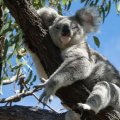Australia's links to South America have just gotten a bit closer, but not due to economic forces, rather fossil forces.
University of Queensland palaeontologist Dr Steve Salisbury was part of an international team of palaeontologists from the US, Argentina and Australia that identified a fossil that had previously only been found in South America.
Dr Salisbury, from UQ's School of Integrative Biology, said an upper arm bone found at Dinosaur Cove in southern Victoria, shares a suite of unique features with a medium-sized predatory dinosaur from Argentina called Megaraptor.
He said it was the first time a dinosaur with unquestionable affinities to animals from other Southern Hemisphere continents had been recognised in Australia.
"Throughout much of the Age of Dinosaurs, Australia formed part of the southern super-continent of Gondwana," Dr Salisbury said.
"As a result, there has long been an expectation that our dinosaur fauna would show similarities to similarly aged faunas from adjoining Gondwanan landmasses, in particular Antarctica, New Zealand and South America.
"Of the Australian dinosaurs that have been recognised so far, the consensus has been that some are relics of groups that went extinct much earlier in other parts of the world, while others have been seen as early representatives of groups that are more typical of the Northern Hemisphere.
"Partly as a result, it has been proposed that Australia was somehow isolated from the rest of Gondwana, either through geographic or climatic barriers.
Dr Federico Angolin, from the Argentinean Museum of Natural Sciences, said when the six palaeontologists on the research team independently recognised the close similarity between the Dinosaur Cove fossil and the remains of Megaraptor from Argentina, they knew they had an important discovery on their hands.
"Megaraptor is a unusual type medium-sized theropod, best known for its enormous clawed hands," Dr Federico Angolin said.
"The proportionately large hand means that Megaraptor has a very distinctive forearm, which is how we were able to identify the Australian fossil.
Project leader Nate Smith, from The Field Museum in Chicago, said fossils of Megaraptor have previously only been found in central and southern Patagonia, in rocks at least 15 million years younger than those in southern Victoria.
He said it was first thought to be a member of Dromaeosauridae, the group of predatory dinosaurs that includes the Velociraptor, but the Australian material has helped show Megaraptor actually belongs to the same group of dinosaurs as Africa's "crocodile mimic" dinosaur Suchomimus and the sail-backed Spinosaurus - the Spinosauroidea.
"The recognition of Megaraptor in Victoria provides the first definitive evidence for interchange between the dinosaur faunas of South America and Australia during the Cretaceous," Mr Smith said.
"Our results are consistent with several geological models for rifting between the southern continents during the time that these dinosaurs existed.
"This discovery indicates that we might need to rethink the longstanding claims of the Northern Hemisphere affinities for many Australian dinosaurs, and of geographic and/or climatic isolation of Australian dinosaur faunas."
The results of the study are published online through the Proceedings of the Royal Society of London
The research was funded by the University of Chicago, Carnegie Museum of Natural History, The National Science Foundation, The Field Museum and The University of Queensland.
Media: Dr Steve Salisbury, The University of Queensland (+61 7 407 788 660; email s.salisbury@uq.edu.au), Nate Smith, The Field Museum of Natural History (+1 319 321 6708; email smithnd@uchicago.edu) or Andrew Dunne at UQ Communications (+61 7 3365 2802 or +61 433 364 181). Images are available from Diana Lilley at The University of Queensland (+61 7 3365 2753, d.lilley@uq.edu.au).
.jpg)



